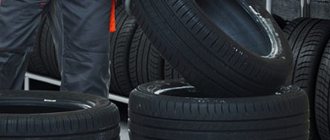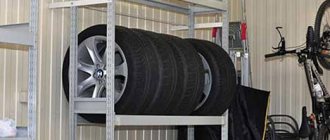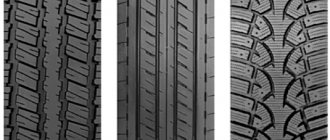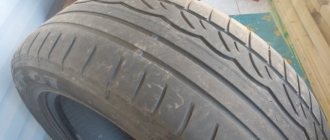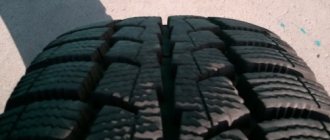Every good vehicle owner has two sets of tires: winter and summer. While one is in use, the other lies in storage in a secluded place, waiting for its season. Therefore, it turns out that each set is inactive for six months. Taking this into account, you should know how to properly store tires without rims and assembled ones, and what rules to follow to maintain their functionality at a high level.
Do not keep tires in the same room with chemicals such as solvents, fuels and lubricants, paints
Tire storage features
Before storing wheels, a thorough inspection should be carried out to ensure that they are suitable for further use. Each tire has wear indicators that help determine the remaining wear. In addition, it is worth examining them for cracks, bumps and hernias.
Important! Before removal, you must mark each tire with a white marker. This will allow you to easily install them in place in the new season and avoid premature wear.
Before storing car tires for seasonal storage, you need to thoroughly clean them of dirt and stones stuck in the tread, as this will accelerate the aging of the rubber and negatively affect its condition.
After complete drying, you need to place the wheels in textile covers made of breathable material, which will ensure air circulation. If they are not available, you can store the tires in plastic bags, but make small holes for ventilation so that condensation does not accumulate inside. It can cause wheel corrosion and rubber over-wetting.
General rules for storing wheels assembled and without rims:
- It is necessary to adhere to a certain temperature regime and avoid sudden changes.
- Tires should be no closer than 1 m from heating devices.
- Complete and non-rimmed wheels should be stored in different positions to avoid deformation.
- Every two months you should turn the wheels and change the fulcrum.
- Tires can be stored outdoors for no more than a month under a canopy or shelter that protects them from external factors.
- It is unacceptable to store wheels on a wet or frozen surface, otherwise deformation cannot be avoided.
- Do not rest tires on sharp objects.
- Do not place heavy objects on top of the wheels.
Selection of storage space
When choosing where to place your wheels while they are not in use, consider the basic requirements for storage space.
In an apartment or house
If you live in an apartment, you can leave your tires:
- In the pantry. The room will be an ideal place to store tires if it is not exposed to steam from the bathroom or too warm air from the kitchen. Make sure there are no chemicals near the rubber.
- In the cellar. The room is perfect for storing tires if it is warm and dry enough.
Please note that storing tires on a staircase or vestibule is against fire safety regulations, and tires may disturb neighbors.
On the balcony
You can store rubber on the balcony only if it is heated and glazed. If you place tires on an open balcony, it will be the same as leaving them on the street, and no storage standard will be met.
If the balcony is suitable for storing rubber, follow these recommendations:
- place the rubber in special covers to protect them from possible exposure to sunlight;
- prepare storage space in advance;
- do not dump tires on a pile or in a stack;
- the best option for placing rubber on the balcony is a vertical position;
- Make sure that there are no other objects on the vertical wheels that could deform the product;
- Rotate your tires periodically to prevent damage.
If you correctly fulfill the described conditions, the tires will lie on the balcony for a long time without losing their technical qualities.
In the garage
If you decide to leave your tires in the garage, pay attention to the following nuances:
- in a garage made of metal sheets, storage is permissible only in winter, since in summer the metal gets very hot;
- a wooden room is better, but it is too fire hazardous;
- During storage, make sure that various chemicals, such as gasoline or solvent, do not come into contact with the surface of the rubber.
The ideal place for tires would be a brick garage. Normal temperature and air humidity will be maintained here. To prevent wheels from taking up much space, equip them with a special shelf or rack.
Car storage
Many car enthusiasts may not use a car with wheels for a long time. To prevent the rubber from deteriorating during this period:
- Place the car on special stands and cover the wheels with covers;
- change the position of the car from time to time so that the pressure on the tires is even;
- unload the interior as much as possible to reduce pressure on the wheels.
At what temperature can tires be stored?
According to existing standards, wheels can be stored at temperatures from -25 to +35 degrees and air humidity at 50-60%. At the same time, sudden jumps should not be allowed.
But it should be borne in mind that storing summer tires in the cold is not recommended, since low temperatures negatively affect their quality. In this case, it is worth maintaining a range from +5 to +35 degrees. Therefore, to store summer tires in winter, you need to select a heated room so that the conditions in it are as close as possible to operating conditions.
When storing winter tires, a significant drop in temperature is allowed, but before installing the wheels, they must be kept at positive temperatures. Ignoring this rule may cause tire deformation and rapid wear.
Despite the fact that winter and summer tires can be stored at elevated temperatures, it should be understood that direct exposure to sunlight has a detrimental effect on rubber. Ultraviolet radiation provokes the appearance of microcracks as a result of drying out, and this also weakens the strength of the tire and increases the likelihood of the tire bursting while driving.
Therefore, to properly store wheels, you need to maintain the temperature within +10... +25 degrees, excluding direct sunlight.
Blackening tires with glycerin and water
The most common method is to use glycerin, which can be easily purchased at the pharmacy. Glycerin is a colorless, viscous and very hygroscopic liquid, miscible with water in any proportions. In order to blacken tires at home, you will need only five jars of 25 ml or three of 40 ml, the preparation method is quite simple, you just need to mix glycerin with water in a ratio of 50 to 50 (1:1).
If you need a greasy solution, then you can use 5 parts of glycerin to 3 parts of water, then you will need not to spray the liquid, as in the first case, but simply apply carefully with a pre-moistened sponge. Also, some experimental drivers use proportions such as 1:3 (high fat effect), 1:5 (light shine) or 1:7 (light matte effect), it all depends on the degree of tire burnout.
The most important advantages of this method are:
- Availability of materials.
- Profitability and minimal financial costs, its cost is about 9 rubles.
- Possibility of fast cooking.
- Possibility of frequent use, and can also be used on black plastic elements of the car body, for example on the bumper.
- the fragility of using the tire, namely drying and cracking of the rubber at low air humidity;
- after application, the rubber will have a shine, but since it is a fatty, sweetish liquid, although the tire will shine, it will literally immediately begin to attract dust;
- After the first contact with water, it is washed off.
The shiny effect can last only 2-3 days and only if there are no heavy rains, so washing the car after application is not recommended, otherwise the tires will return to their previous appearance.
How to treat tires before storage
Tire treatment significantly extends service life
To preserve the quality of rubber, it must be pre-treated with a special aerosol, which is sold in car dealerships. The procedure should be carried out after the tires have been cleaned of dirt and dust, washed and dried.
The product should be applied in 2-3 layers, with a break between them to allow the previous one to dry. Upon completion of processing, each wheel must be placed in a case.
Advice! You need to use a preservative for storage taking into account the type of rubber and strictly according to the instructions.
Silicone oil as a tire blackening agent
This method is quite common among car owners because it is easy to perform. The most commonly used brand for treating tires is PMS-200 - silicone oil 36285, which is a medium-viscosity oil. The price for 1 liter of product, as a rule, does not exceed 1,450 rubles.
This method is naturally more expensive than those described above, but if you buy 1 liter, it will last you for a whole year, even with frequent use. It should also be noted that the effect after application lasts a long time , which is quite economical, with little silicone consumption. As for use, it is also used to lubricate tires that are intended for off-season storage. It is also used to lubricate door seal rubber bands or can be mixed with glycerin. Silicone, unlike other products, perfectly resists ultraviolet radiation and also protects against drying out, dust and condensation, which is a rather impressive fact when choosing the best folk remedy for blackening tires.
Where can you store car wheels?
Storing wheels with or without rims in winter and summer must take into account the basic requirements. To do this, you can use various rooms:
- brick garage;
- glazed balcony;
- storage room;
- basement.
When choosing a location, you need to take into account that it should be dry, since an increased level of moisture negatively affects the quality of the rubber.
It is not recommended to use sheds, attics, or metal garages for storage. This is due to the fact that it is very difficult to maintain optimal conditions in them. An unglazed balcony or loggia is also not suitable for storage, since the sun, wind, moisture and frost will negatively affect the structure of the rubber. This can lead to wheel damage in just one season.
It is important that devices and equipment that emit steam, gas or ozone are not used indoors. It should also be taken into account that contact of rubber with copper and corrosive metals for a long time negatively affects its structure.
If it is not possible to independently ensure the correct storage of assembled wheels and without rims in the garage, you can use the services of tire fitting and car service centers. For this purpose, they have special warehouses with appropriate equipment. This service is paid, but guarantees the preservation of the quality of the rubber. The price for storing one set varies between 2500-3600 rubles.
When storing tires, you need to carefully study the conditions under which they are kept. All this must be spelled out in the contract, which will also stipulate the responsibility of the car service in the event of loss or damage to the wheels. To make sure that all conditions are met, it would be a good idea to take your own measurements in the room.
What is a tire hotel
If you don't have room for tires, you can use a relatively new service - take your wheels to a tire hotel. Such premises are most often equipped by car service centers. Here, all conditions for high-quality storage of rubber are met in the best possible way. The tire hotel has specially trained specialists who prepare the rubber before laying it and ensure that the conditions are met.
Is it necessary to take the wheels to a service center for storage?
It all depends on your financial capabilities and desire to maintain the performance characteristics of the rubber. In fact, the services of a tire hotel are not very expensive, approximately 1500-2500 rubles. per season. Agree, this is several times cheaper than buying new tires if they get damaged during improper storage.
What to look for at a tire hotel
Before sending wheels to a hotel for storage, it is better to independently check whether the storage room is suitable, since some companies neglect the standards prescribed by GOST.
Before concluding an agreement with the service, inspect the premises. It shouldn't be here:
- radiators and other heaters;
- dust and debris;
- windows;
- high humidity;
- mold.
If you notice that the service center neglects suitable conditions for storing rubber and does not provide a guarantee, refuse the company’s services.
In what position should the wheels be stored?
When storing wheels, it is important not only to choose a place and create conditions, but also to know how to properly position the tires. Many car owners do not attach due importance to this, mistakenly thinking that rubber can lose its quality only during operation. But in the absence of loads, tires can also be subject to deformation.
You can store wheels with or without rims. This is not of fundamental importance and depends purely on the personal preferences of the car owner and the availability of free space in the garage. But at the same time, you should figure out how to properly store tires - lying down or standing in both cases, and what to do is strictly prohibited.
In what position should tires be stored without rims?
Tires without rims must be stored vertically
When storing tires without rims, the usual methods cannot be used, otherwise it will not be possible to avoid deformation of tires of even the most expensive and high-quality brands. The best option is to place the tires vertically with support on a wall, rack or on each other. In this case, the rubber should be close, but without the possibility of compression.
Tires without rims should be stored in a garage subject to the following restrictions:
- you cannot hang rubber, as this will lead to deformation under the force of its own gravity;
- It is not recommended to stack them to avoid distortion of the shape and uneven tread wear.
In what position should tires and rims be stored?
Tires mounted on rims must not be stored in a standing position.
According to manufacturers' recommendations, it is best to store wheels with inflated rims. In this case, the possibility of moisture and dust getting on the inner surface of the tire is excluded. There is also no need to re-align the wheels every season, which greatly simplifies the replacement process.
To prevent deformation of the tread under weight, it is necessary to stack the wheels on top of each other in a stack of 2 pieces. It is important to turn over and swap the top and bottom tires every 1-2 months.
Winter and summer tires with discs can also be stored in a suspended state. To do this, you need to wrap the hook in fabric and thread it through the hole in the disk. In this vertical position, the tires can be stored until the next season, but they must be turned over once a month to avoid bending.
Important! When storing rubber with rims, you need to maintain the operating pressure inside the tire at 1 atm.
Folk remedies for blackening tires
In search of a cheap but good alternative that can give a 100% blackening effect, no matter what methods are used, not only the main components of professional products are used, but even carbonated sweet drinks, for example, Coca-Cola or Fanta.
5 folk remedies and several special ones from the section of protective auto chemicals are used with great popularity and with satisfactory effectiveness when blackening tires with your own hands.
The following tire blackening products are available::
- Shoe polish.
- Glycerol.
- Laundry soap.
- Silicone oil.
- Using a special composition
Shelf life of car tires
Any tire, regardless of quality, manufacturer and cost, has a certain expiration date. If all standards for storage and operation of rubber are observed, it does not exceed six years, starting from the date of manufacture.
The duration of operation primarily depends on the quality of the rubber and the special softeners included in its composition. The degree of wear can be determined by visual inspection and by the elasticity of the material. At the end of their expiration date, tires become hard and cracks appear on them, making further use impossible.
Important! Wheels with obvious signs of deformation and wear cannot be used for their intended purpose, as this is dangerous to life.
It has been noticed that car tires that are not subjected to long-term storage can last much longer. This is due to the fact that rubber softeners perform their function only under constant loads, and therefore the material does not lose its elasticity. To extend the shelf life of tires, it is recommended to treat the rubber with special products that create a protective layer on the surface before storing them.
Advice! Summer tires cannot be stored in the cold, since this rubber does not contain special components that can withstand low temperatures.
Our verdict
ink Tire polish based on glycerin gives a not very pronounced effect, which disappears after three days. After this, the tire treated with this product simply looks clean.
LAVR Tire Polish lasts a little longer . For us it is 5 days and 450 km.
The effectiveness of silicone-based gloss products is much more obvious. Both Felix tire dye and the 3 Ton remained effective for a week and more than 600 km, and if it were not for driving on a primer, the tires would remain black with a slight gloss for more than one day.
Another obvious advantage of glossy silicone inks is the hydrophobic effect. In rainy weather, rubber treated with such means is almost not covered with road dirt. Therefore, if you want your tires to maintain an attractive appearance for a long time, choose silicone-based inks with a glossy effect. Or regular silicone grease, which is not inferior in effectiveness to specialized products.
Tires in the Automotive Business ad database
Storage tricks that few people know
- Never hang tires from ropes or cables, as the lack of a support point may result in improper load distribution and the tire may change its original shape. In addition, the use of hooks and stacking rubber on top of each other is also not recommended.
It is important to know: remember, failure to comply with the above conditions may lead not only to a change in shape, but also to a complete loss of performance properties and the possibility of further use.
Should I leave rubber in bags?
Many car owners keep tires in regular garbage bags. Whether this should be done in general depends on the conditions in which the tires will be kept. If in optimal conditions (we wrote about this above), then packages are not needed. If you plan to leave the tires, for example, on an unglazed balcony (under the sun), then bags can help. However, after placing a set of tires in a bag, you should not “tightly” seal it in order to avoid the formation of moisture, and, consequently, corrosion. True, you can buy special bags made of materials that allow air to pass through. They are designed specifically for tires, but they are much more expensive than regular polyethylene.
Wheel covers
Read also: How to make shadows brighter
Prevention measures
Motorists naturally do not want such situations to happen again. Cracks do create problems and require additional financial expenses. And it’s unlikely that anyone would voluntarily want to change a tire every season. High-quality tires are not cheap.
To prevent such problems, it is necessary to adhere to basic operating rules, as well as engage in preventive maintenance of rubber.
This involves following a few simple recommendations:
- Initially, try to buy good quality tires. The better it is, the longer and more efficiently it will last. Good tires provide confident cornering, hold traction firmly, and are not characterized by problems such as cracking.
- Give up the idea of using tires that are not suitable for the current season. Conventional all-season tires actually turn out to be insufficiently effective in winter and summer. Therefore, it is more correct to have 2 sets and change them in accordance with the regulations and current weather conditions.
- Don't forget about preventative measures. This applies to timely washing of tires and the use of special wheel care products. Very often, cracks appear due to contact of rubber with aggressive chemicals, which are constantly scattered on the roads in winter. Therefore, at the end of the trip, you can simply remove the stuck snow with reagents, or wash the wheels with ordinary clean water at least once a week. The more often you can do this, the better.
- Use auto chemicals. In fact, this is not a mandatory requirement, but only one of the options for extending service life. Silicone anti-aging lubricants have proven their effectiveness in practice.
- Follow the operating rules and maintain a calm driving style. Still, the main reason for tire wear and cracking is sitting behind the wheel of a car.
And remember that there is no way to avoid cracks that appear as a result of natural aging. This is a signal that the tire life is running out and it’s time to buy a new set.
Small cracks, if you do not pay attention to them, will soon turn into deep ones. Therefore, try to always monitor the condition of the wheels. This will avoid serious problems.
Other less popular methods for blackening tires
Another way to blacken rubber at home with minimal financial costs using a detergent is to take Mr. muscle or galla (in the form of a gel), but cola , beer and other drinks (in their pure form) that people use create a sticky layer that attracts dust and dirt.
So, in order to return the tires to their former appearance, you need to wash the wheels thoroughly with a glass cleaner, for example Mister Muscle or any other, and then treat them with Coca-Cola. The cola is applied from a spray bottle onto a brush (medium hardness), and then we rub the wheels with it. These steps must be repeated several times, and after the first time it is necessary to allow the liquid to dry. Half a liter of drink is enough for about 10 washes. They say that after all these manipulations the result is not bad, and the rubber is not sticky, and gets its rich black color from cola dyes. You can repeat this method as soon as the blackness begins to disappear.
The situation with dish gel is a little different. Before applying it, you need to wash the wheels well. And then, on a clean surface, apply with a small damp sponge. After processing, you will not need to cover anything else on top. When it dries, it gives a good result. This popular method is often used by car washers.
But be that as it may, it is still not possible to prepare a truly best remedy for blackening tires at home. You will be able to achieve a short jet black effect until the first rain or off-road ride. So the ideal option would be to use specially developed compounds that can be purchased relatively inexpensively.
